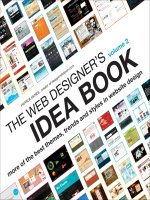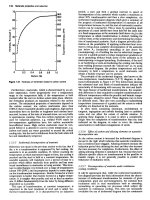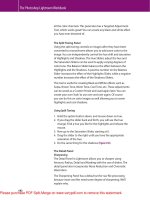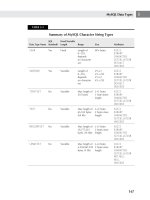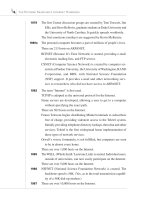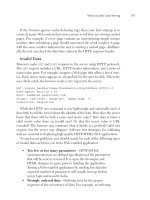The Non-Designer''''s Design Book- P5 pdf
Bạn đang xem bản rút gọn của tài liệu. Xem và tải ngay bản đầy đủ của tài liệu tại đây (4.24 MB, 30 trang )
IE!!
Part 1: Design Principles
Tips on designing web pages
Two of the most important factors in good web design are repetition and
clarity. A visitor should never have to figure out how to use your navigation
system, where they are in the site, or whether they are still in your web site
or have jumped somewhere else.
Repetition
Repeat certain visual elements on every page in your web site. This not only
lets the visitor know they are still at your site, but also provides unity and
continuity, intrinsic features of any good design.
Once you get to content pages, the visitor should find the navigation in the
same place, in the same order, with the same graphics. Not only does this
make it easy for the visitor to find their way through your site, but it provides
a unifying factor to the collection of pages.
Readability
One of the most unreadable places to read text is on a monitor, whether it's
television, video, or computer. So we need to make a few adjustments to the
text on web pages to make sure it's as easy to read as possible.
Use shorter line lengths than you might use on paper. The body copy should
never run the entire width of the web page, which means you must put the
text in a table (or at least use a block indent, which indents the text from both
the left and right sides). But don't use such short line lengths that you break
up the phrasing of the sentences too much.
If you are specifying the text to appear in a certain typeface (if you're not,
ignore this), typically Helvetica or Aria! and Times or Times Roman, please
specify Geneva in front of Helvetica, and New York in front of Times. This
will make the text on Macintoshes appear much so much cleaner and easier
to read. (If you use a Mac, set your default fontto New York instead of Times,
and you will be amazed at how much easier it is to read web pages. Change
it back to Times before you print a page.) Verdana is found on all operating
systems updated within the past few years, and it's an excellent choice for
body copy on the web.
III
The second half of this book
deals specificaUy with type,
since type is what design
is all about, yes?
This section particularly
addresses the problem
of combining more than one
typeface on the page.
Althongh I focus
on the aesthetics of type,
never forget
that your purpose is
communication.
The type should never
inhibit the communication.
If! Part 2: Designing with Type
It)fwt
~
~ 9 ~?
The gods refuse
to answer.
They refuse
because
they
do not
know.
'W.(l9J~
If!
Type (&Life)
Type is the basic building block of any printed page. Often it is irresistibly
compelling and sometimes absolutely imperative to design a page with more
than one typeface on it. But how do you know which typefaces work effectively
together?
In Life. when there is more than one of anything. a dynalI!i£ !;elationship is
established. In Type. there is usually more than one element on a page-even a
document of plain body copy typically has heads or subheads or at least page
numbers on it. Within these dynamics on the page (or in life). a relationship
is established that is either concordant. conflicting. or contrasting.
A concordant relationship occurs when you use only one type
family without much variety in style. size. weight. and so on.
It is easy to keep the page harmonious. and the arrangement
tends to appear quiet and rather sedate or formal-sometimes
downright dull.
A conflicting relationship occurs when you combine typefaces-
that are similar in style. size. weight. and so on. The similarities
are disturbing because the visual attractions are not the same
(concordant). but neither are they different (contrasting). so
they conflict.
A contrasting relationship occurs when you combine separate
typefaces and elements that are clearly distinct from each
other. The visually appealing and exciting designs that attract
your attention typically have a lot of contrast built in. and the
contrasts are emphasized.
Most designers tend to wing it when combining more than one typeface on
a page. You might have a sense that one face needs to be larger or an element
needs to be bolder. However. when you can recognize and name the contrasts.
you have power over them-you can then get to the root of the conflicting
problem faster and find more interesting solutions. And that is the point of
this section.
IfZI
Part 2: Designing with Type
Concord
A design is concordant when you choose to use just one face and the other
elements on the page have the same qualities as that typeface. Perhaps you use
some of the italic version. and perhaps a larger size for a heading. and maybe a
graphic or several ornaments- but the basic impression is still concordant.
Most concordant designs tend to be rather calm and formal. This does not
mean concord is undesirable-just be aware of the impression you give by
using elements that are all in concord with each other.
Lfe's but a walking shadow. a poor player
that struts and frets his hour upon the stage.
and then is heard no more; it is a tale
told by an idiot,fuU of .!oand and fury,
signifying nothing.
This concordant examp'e uses eochin. The ~rst letter is larger
and there is some italic type (eochin Italic). but the entire piece
is rather subdued.
EIGHT: TYPE
(& LIFE)
1m"
Bello!
p
I
I
I
I
Myname Is
I
I
Mytheme song Is
I
I
WhenI growupIwantto be
I
I
I
I
I
I
I
I
I
I
The heavy typeface combines weli with the heavy border. Even the line
for writing on is a bit heavy.
~
cy"",
cvw,
~
UWiW
k~"""",,",,,
~~
~
g>~ & (')fwe, (')~
~
~1
3a:~""tk~
93~~~
~
The typeface, the thin
border, and the delicate
ornaments all give the
senne style impression.
Look familiar? Lots of
folks play it safe with -
their wedding invitations
by using the principle of
concord.
If! Part 2: Designing with Type
Conflict
A design is in conflict when you set two or more typefaces on the same page
that are similar-not really different and not really the same. I have seen
countless students trying to match a typeface with one on the page, looking
for a face that "looks similar:' Wrong. When you put two faces together that
look too much alike without really being so, most of the time it looks like a
mistake. The problem is in the similarities.
concord is a solid and useful concept; conflict should be avoided.
Life's but a walking shadow, a poor player
that struts and frets his hour upon the stage,
and then is heard no more; it is a tale
told by an idiot, full of sound and fury,
signiJYing nothing.
As you read this example, what happens when you get to the phrase,
"full of sound and fury"? Do you wonder why
it's in another type-
face? Do you wonder if perhaps
it's a mistake? Doesit makeyou
twitch? Does the large initio/letter look like it is supposed to be there?
EIGHT: TYPE
(& LIFE)
IFi.I
What's up?
My name is
My theme song is
When I grow up I want to be
look porticulorly ot the "0," the "t," and the
"s"
in the heodllne ond
the other Jines.
They are similar
but not the same. The border is not
the same visual weight as the type or the lines, nor are they in strong
contrast. There istoo much conflict in this little piece.
~
This small invitation uses
two different scripts-
they hove mony
similarities with each
other, but they ore not
the some ond they ore
not different.
CY.uv
a= ~
UWikL
k~Ltv~
~~
~
The ornoments hove the
some type
of conpict. The
piece looks 0 bit cluttered.
~ojwye
r!f
@ke
~
Cfpd 1
3 a:c.£,&, LtvUk,
~
93~S~
*
B Part 2: Designing with Type
Contrast
There is no quality in this world that is not what it is merely by contrast.
Nothing exists in itself. -Herman Melville
Now this is the fun part. Creating concord ispretty easy, and creating conflict
is easy but undesirable. Creating contrast is just fun.
Strong contrast attracts our eyes, as you learned in the previous section about
design. One of the most effective, simplest, and satisfying ways to add contrast
to a design is with type.
Life's but a walking shadow, a poor player
that struts and frets his hour upon the stage,
and then is heard no more;
it is a tale told by an idiot,
full of lou"d ""d
fu,,,,
signifying nothing.
I
In this example it's
very clear that the phrase
"fuli of sound and
fury" is supposed to be in another typeface. The entire piece of
prose has a more exciting visual attraction and a greater energy
due to the contrast of type.
E I G H T TYPE
(& LIFE)
If!
Hello!
My name Is
My theme song Is
When I grow up I want to be
Now the
contrast
between
the typefaces is clear (they are actually in
the same family: Antique olivej-the very bold face contrasts the very
light face. The line weights of the border and writing lines aiso have a
clear distinction.
CY=a=~~
This invitation
uses two very
different faces-
they are different
in many ways.
b~bQ.Wt,
~~!
Pop eye & Olive Oyl
93~S~
The graphic picks
up the strength of
the dark typeface.
adding another
contrast to the script
and creating a
repetitive touch.
lID
Part 2: Designing with Type
Summary
Contrast is not just for the aesthetic look of the piece. It is intrinsically tied in
with the organization and clarity of the information on the page. Never forget
that your point is to communicate. Combining different typefaces should
enhance the communication, not confuse it.
There are six clear and distinct ways to contrast type: size, weight, structure,
form, direction, and color. The rest of this book talks about each of these
contrasts in turn.
Although I elaborate on each of the contrasts one at a time, rarely is one
contrast effective. Most often you will strengthen the effect by combining
and emphasizing the differences.
If you have trouble seeing what is wrong with a combination of typefaces,
don't look for what is different between the faces-look for what is similar. It
is the similarities that are causing the problem.
The one rule to follow when contrasting type is this: don't be a wimp!
But
Before we get to the ways to contrast, you need to have a familiarity with
the categories of type. Spend a couple of minutes with each page in the next
chapter, noting the similarities that unify a category of type. Then try to find
a couple of examples of that kind of type before you move on to the next
category. Look in magazines, books, on packages, anything printed. Believe
me, taking a few moments to do this will make everything sink in so much
faster and deeper!
IDI
Categories>
of type"
There are many thousands of different typefaces available right now, and many
more being created every day. Most faces, though, can be dropped into one
of the six categories mentioned below. Before you try to become conscious
of the contrasts in type, you should become aware of the similarities between
broad groups of type designs, because it is the similarities that cause the
conflicts in type combinations. The purpose of this chapter is to make you
more aware of the details of letterforms. In the next chapter l'lliaunch into
combining them.
Of course, you will find hundreds of faces that don't fit neatly into any
category. We could make several hundred different categories for the varieties
in type
-
don't worry about it. The point is just to start looking at type more
closely and cleady.
I focus on these six groups:
Oldstyle
Modern
Slab serif
Sans serif
E?wijtt
;f)eC€>l"afiwe
1m Part 2: Designing with Type
Oldstyle
Typefaces created in the oldstyle category are based on the handlettering of
scribes-you can imagine a wedge-tipped pen held in the hand. Oldstyles
always have serifs (see the call-out below) and the serifs of lowercase letters
are always at an angle (the angle of the pen). Because of that pen, allthe curved
strokes in the letterforms have a transition from thick to thin, technically
called the "thick/thin transition:' This contrast in the stroke is relatively
moderate, meaning it goes from kind-of-thin to kind-of-thicker. If you draw
a line through the thinnest parts of the curved strokes, the line is diagonal.
This is called the stress-oldstyle type has a diagonal stress.
Serif (pronounced
"sairiff," not
"suh reef")
01
Serifs on lowercase
ty1
e'~~::~
~
Moderote thick/thin
transition in the
strokes
Goudy
Baskerville
Palatino
Times
Garamond
Do these faces all look pretty much the same to you? Don't worry-they look
the same to everyone who hasn't studied typography. Their "invisibility" is
exactly what makes oldstyles the best type group for extensive amounts of
body copy. There are rarely any distinguishing characteristics that get in the
way of reading; they don't call attention to themselves. If you're setting lots
of type that you want people to actually read, choose an oldstyle.
NINE: CATEGORIES OF TYPE 1m
Modern
As history marched on, the structure of type changed. Type has trends
and succumbs to lifestyle and cultural changes, just like hairdos, clothes,
architecture, or language. In the 1700S, smoother paper, more sophisticated
printing techniques, and a general increase in mechanical devices led to type
becoming more mechanical also. New typefaces no longer followed the pen in
hand. Modern typefaces have serifs, but the serifs are now horizontal instead
of slanted, and they are very thin. Like a steel bridge, the structure is severe,
with a radical thick/thin transition, or contrast, in the strokes. There is no
evidence of the slant of the pen; the stress is perfectly vertical. Moderns tend
to have a cold, elegant look.
vertical
streS1
i
serifs on lowercase letters
.0
I'".'""""'-~'
M
~~~.:'::;:-
K.
the strokes
Bodoni
Times Bold
Onyx
WalbaumFenice, Ultra
Modern typefaces have a striking appearance, especially when set very large.
Because of their strong thick/thin transitions, most moderns are not good
choices for extended amounts of body copy. The thin lines almost disappear,
the thick lines are prominent, and the effect on the page is called "dazzling:'
E Part 2: Designing with Type
Slab serif
Along with the industrial revolution came a new concept: advertising. At
first, advertisers took modern typefaces and made the thicks thicker. You've
seen posters with type like that-from a distance, all you see are vertical lines,
like a fence. The obvious solution to this problem was to thicken the entire
letterform. Slab serifs have little or no thick/thin transition.
This category of type is sometimes called Clarendon, because the typeface
Clarendon (shown below) is the epitome of this style. They are also called
Egyptian because they became popular during the Egyptomania phase of
Western civilization; many typefaces in this category were given Egyptian
names so they would sell (Memphis, Cairo, Scarab).
serifs on lowercase letters
a~~ I
Vertical str
$
SS
horizontal and thick (Slab~
~
lab s rif
Clarendon
very little or no thick/thin
transition, or contrast, in the strokes
Memphis
Memphis Extra Bold
New Century Schoolbook
Clarendon
Many of the slab serifs that have a slight thick/thin contrast (such as
Clarendon or New Century Schoolbook) are very high on the readability
scale, meaning they can easily be used in extensive text. They present an
overall darker page than oldstyles, though, because their strokes are thicker
and relatively monoweight. Slab serifs are often used in children's books
because of their clean, straightforward look.
NINE: CATEGORIES OF TYPE II!
Sans serif
The word "sans" means "without" (in French), so sans serif typefaces are those
without serifs on the ends of the strokes. The idea of removing the serifs was
a rather late development in the evolution of type and didn't become wildly
successful until the early part of the twentieth century.
Sans serif typefaces are almost always "monoweight;' meaning there isvirtually
no visible thick/thin transition in the strokes; the letterforms are the same
thickness all the way around.
Also see the following page for important sans serif information.
Noserif
h
anywhere
~~.'"""",,?
W inthestrokes
NO stress because
there's no thick/thin
serif
Franklin Gothic
Antique Olive
Formata
Folio Franklin Gothic
Futu
ro, Condensed
Syntax
If the only sans serifs you have in your font library are Helvetica and Avant
Garde, the best thing you could do for your pages is invest in a sans serif family
that includes a strong, heavy, black face. Each of the families above has a wide
variety ofweights, from light to extra black. With that one investment, you will
be amazed at how your options increase for creating eye-catching pages.
II Part 2: Designing with Type
Most sans serifs are monoweight, as shown on the preceding page. A very
few, however, have a slight thick/thin transition. Below is an example of a
sans serif with a stress, called Optima. Faces like Optima are very difficult
to combine on a page with other type- they have similarities with serif
faces in the thick/thin strokes, and they have similarities with sans serifs
in the lack of serifs. Be very careful when working with a sans like this.
Sans serif
Optima
Optima is an exceptionally beautiful typeface, but you
must be very careful about combining it with other faces.
Notice its thick/thin strokes. It has the classic grace of an
oldstyle, but with the serifs removed.
Ever51Ot~e t~ilt
'What the ~i@k'
ISalways
the right d~cision?
,
-Nancy Davis
Here you see Optima combined with Spumoni.
spumoni's spunky informality is a nice contrast
with Optima's classic grace.
NINE: CATEGORIES OF TYPE
III"
script
The script category includes all those typefaces that appear to have been
handlettered with a calligraphy pen or brush, or sometimes with a pencil or
technical pen. This category could easily be broken down into scripts that
connect, scripts that don't connect, scripts that look like hand printing, scripts
that emulate traditional calligraphic styles, and so on. But for our purposes
we are going to lump them all into one pot.
EfP~ §2Joktw
.J2e:;y,'J
Cascade ~ Zapf Chancery
t4rtd'
Scripts are like cheesecake-they should be used sparingly so nobody gets
sick. The fancy ones, of course, should never be set as long blocks of text
and never as all caps. But scripts can be particularly stunning when set very
large-don't be a wimp!
III
Part 2: Designing with Type
Decorative
Decorative fonts are easy to identify -if the thought of reading an entire
book in that font makes you wanna throw up. you can probably put it in the
decorative pot. Decorative fonts are great -they're fun. distinctive. easy to use,
oftentimes cheaper, and there is a font for any whim you wish to express. Of
course, simply because they are so distinctive. their powerful use is limited.
Potrzebie
<P~l"rty
~ous Henry
FAJI'YA
JtJNIPER
$:CJ\!LfII
Improv
Juice
When using a decorative typeface. go beyond what you think of as its initial
impression. For instance. ifImprov strikes you as informal. try using it in a more
formal situation and see what happens. If you think Juniper carries a WIld West
flavor, try it in a corporate setting or a flower shop and see what happens.
Depending on how you use them, decoratives can carry obvious emotions, or
you can manipulate them into carrying connotations very different from your
first impression. But that is a topic for another book.
ToJa
a
'S
K
~i~htY
0
ISJUSf
n
t
esterJ y's
f!at!elh 9~ J.
wisdom sometimes benefits from the use of
decorative fonts.
NINE: CATEGORIES OF TYPE
Bm
Be conscious
To use type effectively, you have to be conscious. By that I mean you must keep
your eyes open, you must notice details, you must try to state the problem
in words. Or when you see something that appeals to you strongly, put into
words why it appeals to you.
Spend a few minutes and look through a magazine. Try to categorize the
typefaces you see. Many of them won't fit neatly into a single pot, but that's
okay-choose the category that seems the closest. The point is that you are
looking more closely at letterforms, which is absolutely critical ifyou are going
to combine them effectively.
Little Quiz #3: categories of type
Draw lines to match the category with the typeface!
Oldstyle
.1' 1"N,J;ROnJ;O
Modern
High Society
Slab serif
&00 EfPaMj/ ~
~~
Sans serif
As I remember, Adam
Script
The enigma continues
Decorative
It's your attitude
IE!!I Part 2: Designing with Type
Little Quiz #4: Thick/thin transitions
Do the following typefaces have:
A moderate thick/thin transitions
B radical thick/thin transitions
C no (or negligible) thick/thin transitions
Giggle
ABC
Diggle
ABC
Higgle
ABC
Jiggle
ABC
Piggle
ABC
Wiggle
ABC
NINE: CATEGORIES OF TYPE
lED"
Little Quiz #5: Serifs
Do the lowercase letters in the examples below have:
A thin, horizontal serifs
B thick, slabby [hint] horizontal serifs
C no serifs
D slanted serifs
Diggle
Riggle
ABC D
ABC D
Figgle
Biggle
ABC D
ABC D
Miggle
Tiggle
ABC D
ABC D
Notice the huge differences between all the
"g" 'etters! Too much fun.
lIB Part 2: Designing with Type
Summary
I can't stress enough how important it is that you become conscious of these
broad categories of type, As you work through the next chapter, it will become
clearer why this is important.
A simple exercise to continually hone your visual skills is to collect samples of
the categories. Cut them out of any printed material you can find. Do you see
any patterns developing within a broad category? Go ahead and make subsets,
such as oldstyle typefaces that have small x-heights and tall descenders (see
the example below). Or scripts that are really more like hand printing than
cursive handwriting. Or extended faces and condensed faces (see below). It is
this visual awareness of the letterforms that will give you the power to create
interesting, provocative, and effective type combinations.
B~~~
30 point
~
Ascenders are the parts of letters
thot ore toller thon the x-height.
The x-height is the height of the
main body of the lowercose letters.
Descenders are the parts of letters
thot ore beiow the baseline (the
invisible line on which the type sits).
Notice the x-height of Bernhord os compo red to Eurostile, below. look ot the
x-height in relation to the ascenders. Bernhard has an unusually small x-height
and unusually tall ascenders. Most sans serifs have large x-heights. start noticing
those kinds of detoils.
Eurostile Bold
18 paint
Eurastile Bald
Eurostile Bold Condensed
Extended
Extended typefoces look stretched out; condensed typefaces appear to be squished.
Both are appropriate in certain circumstances.
iii
It
I
/
I
'"
This chapter focuses on the topic of combining typefaces. The following pages
describe the various ways type can be contrasted. Each page shows specific
examples, and at the end of this section are examples using these principles
of contrasting type on your pages. Type contrast is not only for the aesthetic
appeal, but also to enhance the communication.
A reader should never have to try to figure out what is happening on the
page-the focus, the organization of material, the purpose, the flow of infor-
mation, all should be recognized instantly with a single glance. And along the
way, it doesn't hurt to make it beautiful!
These are the contrasts I discuss:
Size
Weight
StrUCture
~RM
~.~~e~
Color
III Part 2: Designing with Type
Size
In which category
of
type does this
face belong7
A contrast
of
size is fairly
obvious: big type versus little type. To make a contrast
of size work effectively, though, don't be a wimp. You cannot contrast 12-point
type with 14-point type; most of the time they will simply conflict. You can-
not contrast 6s-point type with 72-point type. If you're going to contrast two
typographic elements through their size, then do it. Make it obvious-don't
let people think it's a mistake.
HEY, SHE'S C ALL IN G YOU A LIT T L E
WIMP
Decide
on the typographic element that you want seen as a focus.
Emphasize it with contrasts.
Dewsletter
Volume 1 .Number 1
January. 2008
If other typographic elements have to be there, but they aren't
really that important to the general reading public, make them
small. Who cares what the volume number is? Ifsomeone does
care, it can still
be
read. It's okay not to set it in 12-point type!
